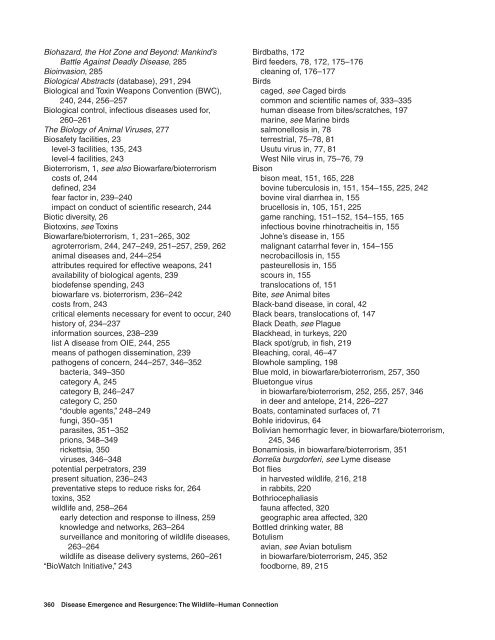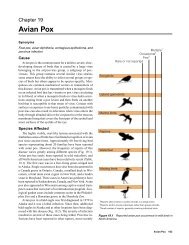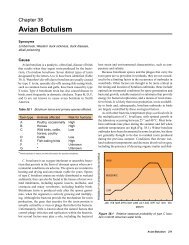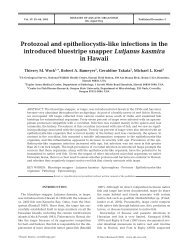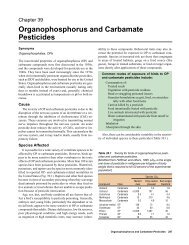Scientific names of animals and plants can be found in Appendix B. A
Scientific names of animals and plants can be found in Appendix B. A
Scientific names of animals and plants can be found in Appendix B. A
Create successful ePaper yourself
Turn your PDF publications into a flip-book with our unique Google optimized e-Paper software.
Biohazard, the Hot Zone <strong>and</strong> Beyond: Mank<strong>in</strong>d’s<br />
Battle Aga<strong>in</strong>st Deadly Disease, 285<br />
Bio<strong>in</strong>vasion, 285<br />
Biological Abstracts (database), 291, 294<br />
Biological <strong>and</strong> Tox<strong>in</strong> Weapons Convention (BWC),<br />
240, 244, 256–257<br />
Biological control, <strong>in</strong>fectious diseases used for,<br />
260–261<br />
The Biology <strong>of</strong> Animal Viruses, 277<br />
Biosafety facilities, 23<br />
level-3 facilities, 135, 243<br />
level-4 facilities, 243<br />
Bioterrorism, 1, see also Biowarfare/bioterrorism<br />
costs <strong>of</strong>, 244<br />
def<strong>in</strong>ed, 234<br />
fear factor <strong>in</strong>, 239–240<br />
impact on conduct <strong>of</strong> scientific research, 244<br />
Biotic diversity, 26<br />
Biotox<strong>in</strong>s, see Tox<strong>in</strong>s<br />
Biowarfare/bioterrorism, 1, 231–265, 302<br />
agroterrorism, 244, 247–249, 251–257, 259, 262<br />
animal diseases <strong>and</strong>, 244–254<br />
attributes required for effective weapons, 241<br />
availability <strong>of</strong> biological agents, 239<br />
biodefense spend<strong>in</strong>g, 243<br />
biowarfare vs. bioterrorism, 236–242<br />
costs from, 243<br />
critical elements necessary for event to occur, 240<br />
history <strong>of</strong>, 234–237<br />
<strong>in</strong>formation sources, 238–239<br />
list A disease from OIE, 244, 255<br />
means <strong>of</strong> pathogen dissem<strong>in</strong>ation, 239<br />
pathogens <strong>of</strong> concern, 244–257, 346–352<br />
bacteria, 349–350<br />
category A, 245<br />
category B, 246–247<br />
category C, 250<br />
“double agents,” 248–249<br />
fungi, 350–351<br />
parasites, 351–352<br />
prions, 348–349<br />
rickettsia, 350<br />
viruses, 346–348<br />
potential perpetrators, 239<br />
present situation, 236–243<br />
preventative steps to reduce risks for, 264<br />
tox<strong>in</strong>s, 352<br />
wildlife <strong>and</strong>, 258–264<br />
early detection <strong>and</strong> response to illness, 259<br />
knowledge <strong>and</strong> networks, 263–264<br />
surveillance <strong>and</strong> monitor<strong>in</strong>g <strong>of</strong> wildlife diseases,<br />
263–264<br />
wildlife as disease delivery systems, 260–261<br />
“BioWatch Initiative,” 243<br />
Birdbaths, 172<br />
Bird feeders, 78, 172, 175–176<br />
clean<strong>in</strong>g <strong>of</strong>, 176–177<br />
Birds<br />
caged, see Caged birds<br />
common <strong>and</strong> scientific <strong>names</strong> <strong>of</strong>, 333–335<br />
human disease from bites/scratches, 197<br />
mar<strong>in</strong>e, see Mar<strong>in</strong>e birds<br />
salmonellosis <strong>in</strong>, 78<br />
terrestrial, 75–78, 81<br />
Usutu virus <strong>in</strong>, 77, 81<br />
West Nile virus <strong>in</strong>, 75–76, 79<br />
Bison<br />
bison meat, 151, 165, 228<br />
bov<strong>in</strong>e tu<strong>be</strong>rculosis <strong>in</strong>, 151, 154–155, 225, 242<br />
bov<strong>in</strong>e viral diarrhea <strong>in</strong>, 155<br />
brucellosis <strong>in</strong>, 105, 151, 225<br />
game ranch<strong>in</strong>g, 151–152, 154–155, 165<br />
<strong>in</strong>fectious bov<strong>in</strong>e rh<strong>in</strong>otracheitis <strong>in</strong>, 155<br />
Johne’s disease <strong>in</strong>, 155<br />
malignant catarrhal fever <strong>in</strong>, 154–155<br />
necrobacillosis <strong>in</strong>, 155<br />
pasteurellosis <strong>in</strong>, 155<br />
scours <strong>in</strong>, 155<br />
translocations <strong>of</strong>, 151<br />
Bite, see Animal bites<br />
Black-b<strong>and</strong> disease, <strong>in</strong> coral, 42<br />
Black <strong>be</strong>ars, translocations <strong>of</strong>, 147<br />
Black Death, see Plague<br />
Blackhead, <strong>in</strong> turkeys, 220<br />
Black spot/grub, <strong>in</strong> fish, 219<br />
Bleach<strong>in</strong>g, coral, 46–47<br />
Blowhole sampl<strong>in</strong>g, 198<br />
Blue mold, <strong>in</strong> biowarfare/bioterrorism, 257, 350<br />
Bluetongue virus<br />
<strong>in</strong> biowarfare/bioterrorism, 252, 255, 257, 346<br />
<strong>in</strong> deer <strong>and</strong> antelope, 214, 226–227<br />
Boats, contam<strong>in</strong>ated surfaces <strong>of</strong>, 71<br />
Bohle iridovirus, 64<br />
Bolivian hemorrhagic fever, <strong>in</strong> biowarfare/bioterrorism,<br />
245, 346<br />
Bonamiosis, <strong>in</strong> biowarfare/bioterrorism, 351<br />
Borrelia burgdorferi, see Lyme disease<br />
Bot flies<br />
<strong>in</strong> harvested wildlife, 216, 218<br />
<strong>in</strong> rabbits, 220<br />
Bothriocephaliasis<br />
fauna affected, 320<br />
geographic area affected, 320<br />
Bottled dr<strong>in</strong>k<strong>in</strong>g water, 88<br />
Botulism<br />
avian, see Avian botulism<br />
<strong>in</strong> biowarfare/bioterrorism, 245, 352<br />
foodborne, 89, 215<br />
360 Disease Emergence <strong>and</strong> Resurgence: The Wildlife–Human Connection


